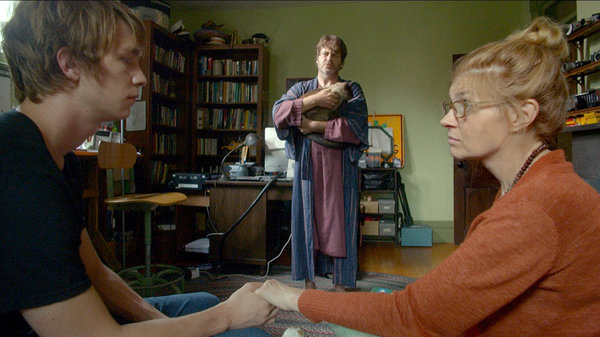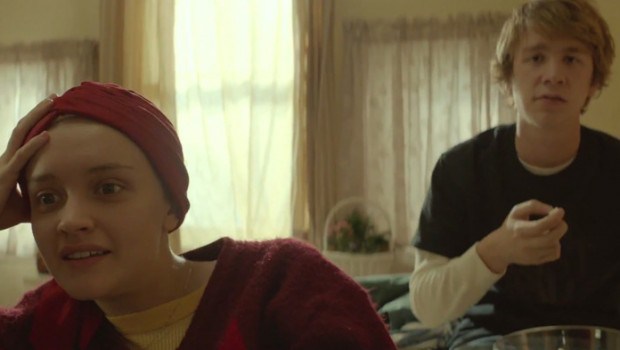I often censure movies for being generic; no film is more hollow than one without a personality. The flip side, however, is the movie that pummels its audience into submission via a surfeit of quirk. This is why Me and Earl and the Dying Girl—Alfonso Gomez-Rejon’s skillfully made, unrelentingly precious, ultimately insufferable weepie—is a strangely worthwhile brand of disappointment. It is by no means lacking in individuality, and it sporadically sparkles with wit and ingenuity. But it channels its eccentricity in frustratingly clichéd ways, bludgeoning viewers with an onslaught of tackiness and schmaltz. It tries very hard to win your heart, and its calculated efforts to do so make it both laudable and oddly detestable.
Here is an example of this movie’s shtick: During one of his shaggy-dog voiceovers, Greg Gaines (Thomas Mann) analogizes hot girls—in particular the oblivious manner in which they exert their sexuality and power over horny boys—to moose inadvertently trampling over helpless chipmunks. It’s a cute enough metaphor, and the first time Greg describes it, Gomez-Rejon cuts to a crude piece of claymation that playfully illustrates two such animals acting out that very scenario. That’s a wry bit of visual inventiveness and formal looseness, but Me and Earl and the Dying Girl can’t let well enough alone. For the remainder of the movie, every time the token hot girl carelessly touches Greg’s shoulder, Gomez-Rejon returns to that image of the anthropomorphic moose and its pitiful chipmunk victim. The film desperately wants you to sympathize with the chipmunk (and, by proxy, Greg), and it actually half-succeeds; by the time it ends, you, too, will feel like you’ve been stomped on repeatedly.
Greg, as you might suspect, is the “me” of Me and Earl and the Dying Girl, which won both the Grand Jury Prize and the Audience Award at this year’s Sundance Film Festival. He is a diffident high school senior who is socially agnostic and thus aggressively bland; he floats from one clique to the next, rigorously avoiding commitment and thus thwarting the possibility of being pigeonholed as a particular type. His mother (a fantastic Connie Britton) is the doting sort, constantly nuzzling into her son’s private affairs, while his father (Nick Offerman) is a tenured sociology professor who totters around in his robe and serves exotica like pig’s feet. Oh, and their cat is named Cat Stevens.
Get the picture? Screenwriter Jesse Andrews, adapting his novel, has admirably attempted to distinguish Greg from your run-of-the-mill teenage protagonist, but he has confused idiosyncrasy with depth. Greg is certainly different, but every difference feels carefully cultivated to the point that, rather than vibrating with detail and dimension, he feels flat and artificial. Andrews tries in earnest to make Greg interesting, but he just ends up interestingly boring.
Greg is nevertheless better drawn than the movie’s second title character. Earl Jackson (RJ Cyler) is Greg’s best and perhaps only friend, though even that label is too intimate for Greg, who prefers to refer to Earl as a coworker. He speaks in Ebonics, his favorite word is “titties”, and his primary function appears to be his relative normalcy; his ability to interact with others without panicking demonstrates just what a weirdo Greg is. It’s possible to envision a movie where Earl exists as a meaningful character, but in Me and Earl he is simply a cracked mirror, revealing Greg’s faults but never demonstrating any true persona himself.
Earl serves a purpose, however. Together, he and Greg have collaborated on 42 different amateur short films, which are punny parodies of the cinematic canon. (Their catalog—or “oeuvre”, as Greg’s father calls it—includes The 400 Bros, A Sockwork Orange, and My Dinner with Andre the Giant.) These films, which we catch glimpses of throughout Me and Earl, are the movie’s cleverest touch, even if they also expose its defects. It is always enjoyable to spot references to classic pictures, and the Gaines/Jackson productions (as they are named) twinkle with twisted energy and delightful oddness. There is a liberating individuality to these mini-movies that Gomez-Rejon attempts to replicate on a larger scale, whether by subdividing his film via chapter titles (“The part where Earl holds nothing sacred;” “The part after all the other parts”) or by enlivening the proceeds with bizarre supporting characters, like a terrible teen rapper or a trench coat-wearing goth. (The invaluable Jon Bernthal pops up as a muscular, tattooed history teacher who repeats the mantra, “Respect the research!” because he’s such a cool teacher.) But while the Gaines/Jackson films effectively generate short bursts of energy, Gomez-Rejon’s approach quickly becomes enervating. It is easier to be weird and clever for a few minutes than for several hours.
Thank goodness, then, for the dying girl. That would be Rachel (Olivia Cooke), a classmate of Greg’s who is diagnosed with leukemia. (Before her illness, she was, according to Greg’s studious hierarchy, a member of Boring Jewish Senior Girls, Subgroup 2A.) At the urging of his mother, Greg resolves to make friends with Rachel, and she eventually consents through an apparent combination of curiosity and weariness. Their “doomed friendship” is not entirely plausible—little about this movie is—but it yields some gratifyingly low-key and persuasive moments. The best scenes in Me and Earl and the Dying Girl involve Greg and Rachel just hanging out in her room, tentatively exploring each other’s boundaries and feelings. In these moments, Gomez-Rejon finally relaxes and stops trying to impress you with his slick camerawork, relying instead on the naturalism of Andrews’s dialogue and the appeal of his actors. Mann’s performance is tricky—though in a sense, it is singularly successful, assuming its goal is to make you want to throttle Greg into next week—but he does his best work opposite Cooke. His costar fares better; Cooke beautifully plays up Rachel’s frailty without ever demanding your sympathy.
Sadly, the same cannot be said of Me and Earl as a whole. Sympathy is its stock in trade, and the movie operates like a virus, systematically attacking your defenses and preying on your capacity for compassion. It is hardly the first (nor the worst) of its kind, and in charting the gradual decay of an attractive and defiant teenager, it immediately recalls The Fault in Our Stars. But while that film, buoyed by an incandescent performance from Shailene Woodley, was similarly tear-jerking, it was somehow honest in its efforts to wring sobs from its audience. Me and Earl and the Dying Girl, by contrast, is unforgivably manipulative. It will settle for nothing less than absolute dominion over your emotions, and its techniques in accomplishing this end—including repeatedly lying to you—are downright cowardly.
Or perhaps I would be more forgiving if only it made more sense. The thrust of Me and Earl and the Dying Girl, beyond Greg and Rachel’s burgeoning friendship, is Greg and Earl’s attempt to make a film for Rachel before she dies. It’s an idea suggested by Madison (Katherine C. Hughes), the aforementioned hot girl/moose who for some reason finds Greg endearing. (Seriously, in what possible universe does a babe like Madison not have a date for the prom?) How exactly this would help Rachel is unclear, but everyone in the movie treats Greg and Earl’s task as monumentally important. As a result, Greg spends most of his time either working on his tribute to Rachel or, more infuriatingly, not working on it and telling people that he isn’t working on it, causing much consternation. (It also leads to a feeble subplot about Greg’s academic struggles; this explains the film’s strained framing device, with Greg narrating his college application essay, a stunt that unwisely recalls the far superior The Spectacular Now.) Meanwhile, friendships disintegrate, relationships change, tears are shed, and nothing feels real (least of all Molly Shannon as Rachel’s dippy mother). Trauma can be a forceful cinematic tool, but not when it feels so arbitrary and manufactured.
Greg repeatedly declares that the film he and Earl have made for Rachel “sucks”. This is no doubt designed to be false modesty, and Me and Earl and the Dying Girl is confident that once you see their micro-budget documentary, you will be overwhelmed by its power and purity. But here’s the thing: It does suck. It is little more than a collage of shapes and faces, and while the glimpses of the other Gaines/Jackson productions that we witness show the promise of scrappy and funny guerrilla filmmaking, their purported pièce de résistance is shallow and self-serving. It is, in other words, a movie that is unworthy of Rachel and her painful, valiant struggle. So is this one.
Jeremy Beck is the editor-in-chief of MovieManifesto. He watches more movies and television than he probably should.



